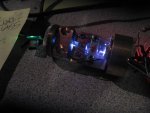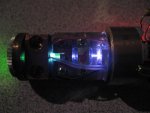Krutz
0
- Joined
- Nov 21, 2007
- Messages
- 1,733
- Points
- 48
impressive! what output was advertised? i would put this module in a bigger host..
and whoa, thats a huge doubler crystal! if its around 100mw from this, i would consider doing some blue experiments too
with 700mA i get 100mW green from my o-like module too. a totally different world, compared to your module. so much potential, 100mW green is almost an insult for this!
dave has a blue crystal set from a burned out pointer, by the way.. ;-)
..and there was a blue crystal set on ebay, someday..
manuel
and whoa, thats a huge doubler crystal! if its around 100mw from this, i would consider doing some blue experiments too
with 700mA i get 100mW green from my o-like module too. a totally different world, compared to your module. so much potential, 100mW green is almost an insult for this!
dave has a blue crystal set from a burned out pointer, by the way.. ;-)
..and there was a blue crystal set on ebay, someday..
manuel





